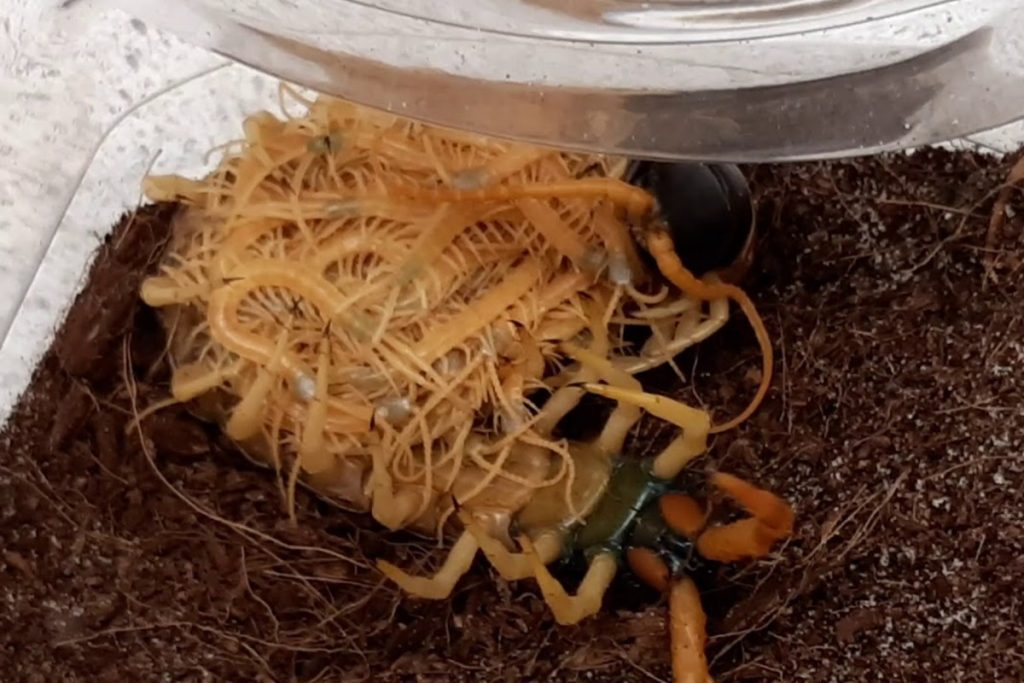The Unbelievable Story of a Giant Desert Centipede Mother Who Stayed with Her Babies Until the Very End

When we think about motherhood, we usually picture something warm and nurturing — maybe a bird feeding its chicks or a lioness keeping watch over her cubs. But in the quiet, dusty corners of the American Southwest, there’s another mother whose story doesn’t fit that warm image at all. She’s not cuddly. She’s not soft. She has dozens of legs, venomous claws, and a body that sends shivers down your spine.
She’s a giant desert centipede, and her story is one of the most intense examples of motherhood in the animal world. Because for her, being a mother doesn’t just mean guarding and caring for her babies. Sometimes, it means offering them her body — literally — so they can survive.
Let’s talk about it.
Life Beneath the Rocks

If you’ve ever taken a walk in the desert and flipped over a rock, you may have met her. Bright orange legs, a long black-and-red body, and the kind of speed that makes you flinch even if you weren’t scared before. That’s Scolopendra heros, or the giant desert centipede. These creatures are built for survival in dry, harsh places. They move fast, hunt at night, and aren’t picky eaters. Crickets, spiders, lizards — even small rodents — are all fair game for this surprisingly fierce predator.
But despite her fearsome reputation, the giant desert centipede has a side of her story most people never hear. When a female centipede lays her eggs — sometimes dozens of them — she doesn’t just walk away. She wraps her entire body around the egg cluster and stays there. Not for minutes. Not for hours. But for days. Sometimes weeks. She doesn’t eat. She doesn’t leave. She just waits.
And while she waits, she cleans her eggs one by one. This isn’t just a neat habit — it’s how she protects them from bacteria, fungi, and predators. If something dangerous comes near, she’ll raise her head and defend the nest with her venomous claws.
There’s no affection the way humans show it. But there’s something powerful about that image: a mother in complete stillness, giving up her needs to make sure her young are safe.
When Love Turns to Sacrifice
Now here’s where it gets even more intense — and yes, emotional, in a way that only nature can deliver.
After the babies hatch, they’re helpless. Tiny, pale versions of their mother, barely able to move. And she keeps protecting them. She wraps around them, just like she did with the eggs. But unlike most animal moms, she doesn’t feed them or go hunting. She just… stays.
Here’s the part that has fascinated scientists and shocked anyone who hears it: in rare but documented cases, those baby centipedes end up eating their own mother.
It’s called matriphagy — a term that literally means “eating the mother.” It’s not common in most animals, but it does happen in nature. Some spiders do it. A few insects. Even a few rare amphibians. And now, some experts believe that Scolopendra heros might be part of that small list.
But this isn’t some horror story. It’s not mindless violence. In the wild, the desert doesn’t wait. Food is scarce. Life is short. And the mother centipede, after days or weeks of not eating, grows weak. Her body starts breaking down. Her babies, guided by instinct, find nourishment in her.
Is it cruel? Or is it just another way of giving?
That’s the strange thing about this story. It makes you think. The centipede mother didn’t walk away. She stayed, even knowing that her body might be the only thing that gives her babies a chance. That’s not something she decided with emotion — it’s nature. But the result is still deeply moving.
It makes you wonder: how many times in the animal world does a parent give everything and then disappear, their story forgotten as the young move forward?
A Reminder from the Desert

What’s fascinating about this whole journey is how easily we overlook it. The giant desert centipede isn’t a zoo favorite. It’s not cute or cuddly. Most people want to squash it or scream when they see one. But under all that armor and speed, she’s a living example of quiet strength.
You don’t have to love bugs to see the meaning here.
We often forget that the wild isn’t just about predators and prey. It’s also full of mothers and fathers, of small acts of care, of creatures that protect their young in the only way they know how. And sometimes, that means giving their very last breath so that the next generation has a chance.
So the next time you’re in the desert — or even just scrolling past a picture of a giant centipede — remember her. Not for the way she looks or how scary she seems, but for the story she carries in her body. A story of stillness. Of survival. And of a kind of love that doesn’t need words.
In the end, her sacrifice might be quiet. But it’s not forgotten.



